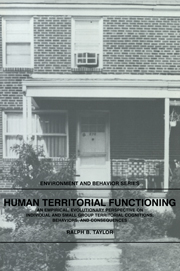 Human Territorial Functioning
Human Territorial Functioning The present volume examines human territorial functioning, a closely linked constellation of place-specific, socially determined and influential cognitions, behaviors, and sentiments. Territorial functioning encompasses a class of environment–behavior transactions concerned with issues of personal and group identity, cohesiveness, control, access, and ecological management. This functioning applies largely to small groups, and the individuals in those groups, and is limited largely to small-scale, delimited spaces. The present chapter outlines the purposes of this book, sketches its major recurrent themes, and presents in capsule form a lowlevel theory, or model, of human territorial functioning. The materials to be covered in the various sections are also introduced.
Focus
The concept of human territorial functioning addresses the question: How do people “manage” the locations they own, occupy, or use for varying periods of time? Approaching this question is difficult, for two reasons.
Some problems
First, everyone knows something about territoriality, based on personal experience. Children at camp vie for the top bunks, siblings get upset and scream when a sister or brother enters their room unannounced, and in some households no one is allowed in the kitchen when dad is baking a cake. Frequently, territorial issues are resolved in the legal arena (see accompanying box). Further, territoriality is ensconced in our everyday lexicon with references to “turf battles” or phrases such as “a man's home is his castle”. (But see Figure 1.1.) Movies may trade on everyday notions of how people are territorial, Sam Peckinpah's Straw Dogs of the early 1970's or the more recent The Warriors being cases in point.
To save this book to your Kindle, first ensure [email protected] is added to your Approved Personal Document E-mail List under your Personal Document Settings on the Manage Your Content and Devices page of your Amazon account. Then enter the ‘name’ part of your Kindle email address below. Find out more about saving to your Kindle.
Note you can select to save to either the @free.kindle.com or @kindle.com variations. ‘@free.kindle.com’ emails are free but can only be saved to your device when it is connected to wi-fi. ‘@kindle.com’ emails can be delivered even when you are not connected to wi-fi, but note that service fees apply.
Find out more about the Kindle Personal Document Service.
To save content items to your account, please confirm that you agree to abide by our usage policies. If this is the first time you use this feature, you will be asked to authorise Cambridge Core to connect with your account. Find out more about saving content to Dropbox.
To save content items to your account, please confirm that you agree to abide by our usage policies. If this is the first time you use this feature, you will be asked to authorise Cambridge Core to connect with your account. Find out more about saving content to Google Drive.